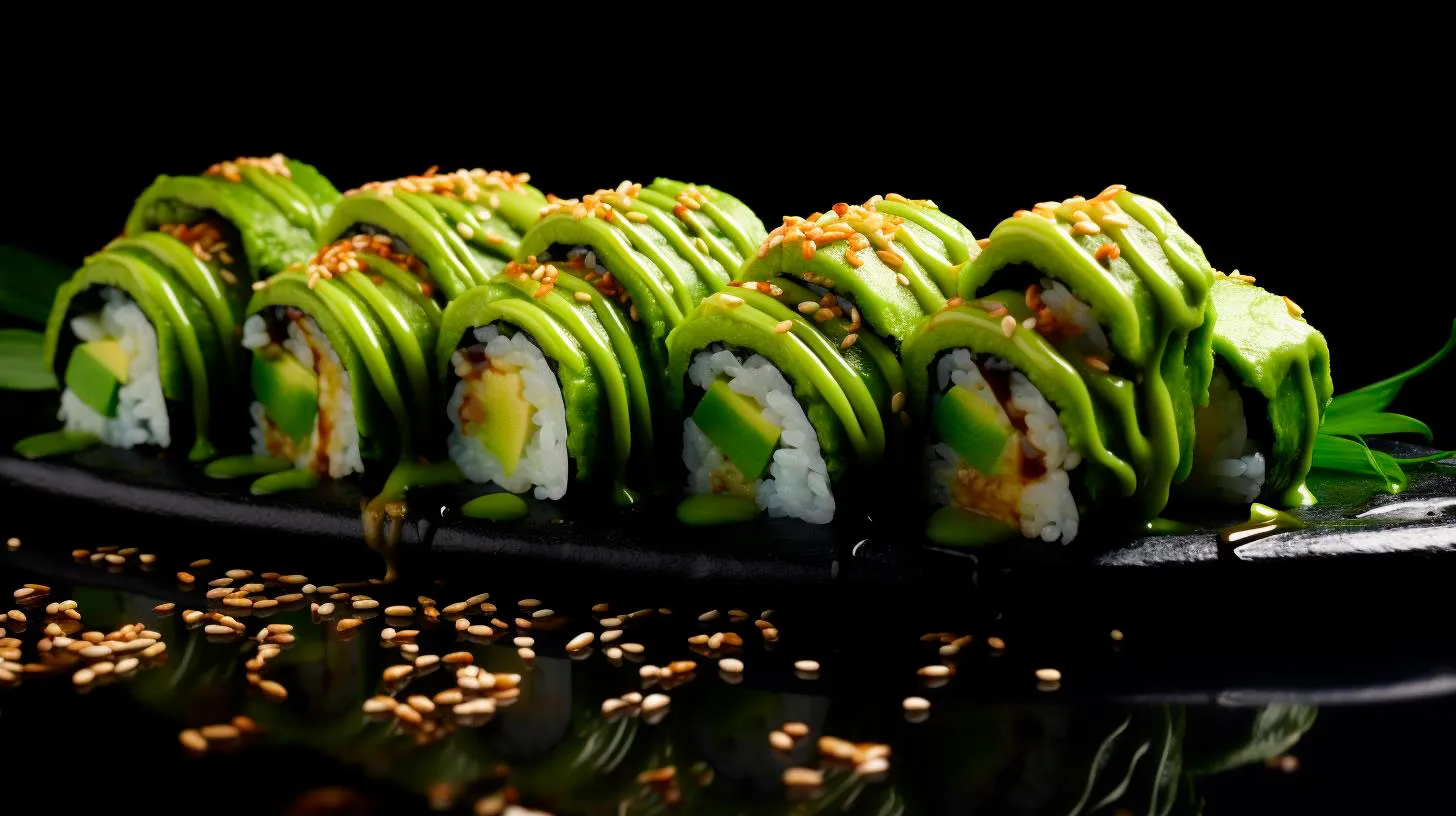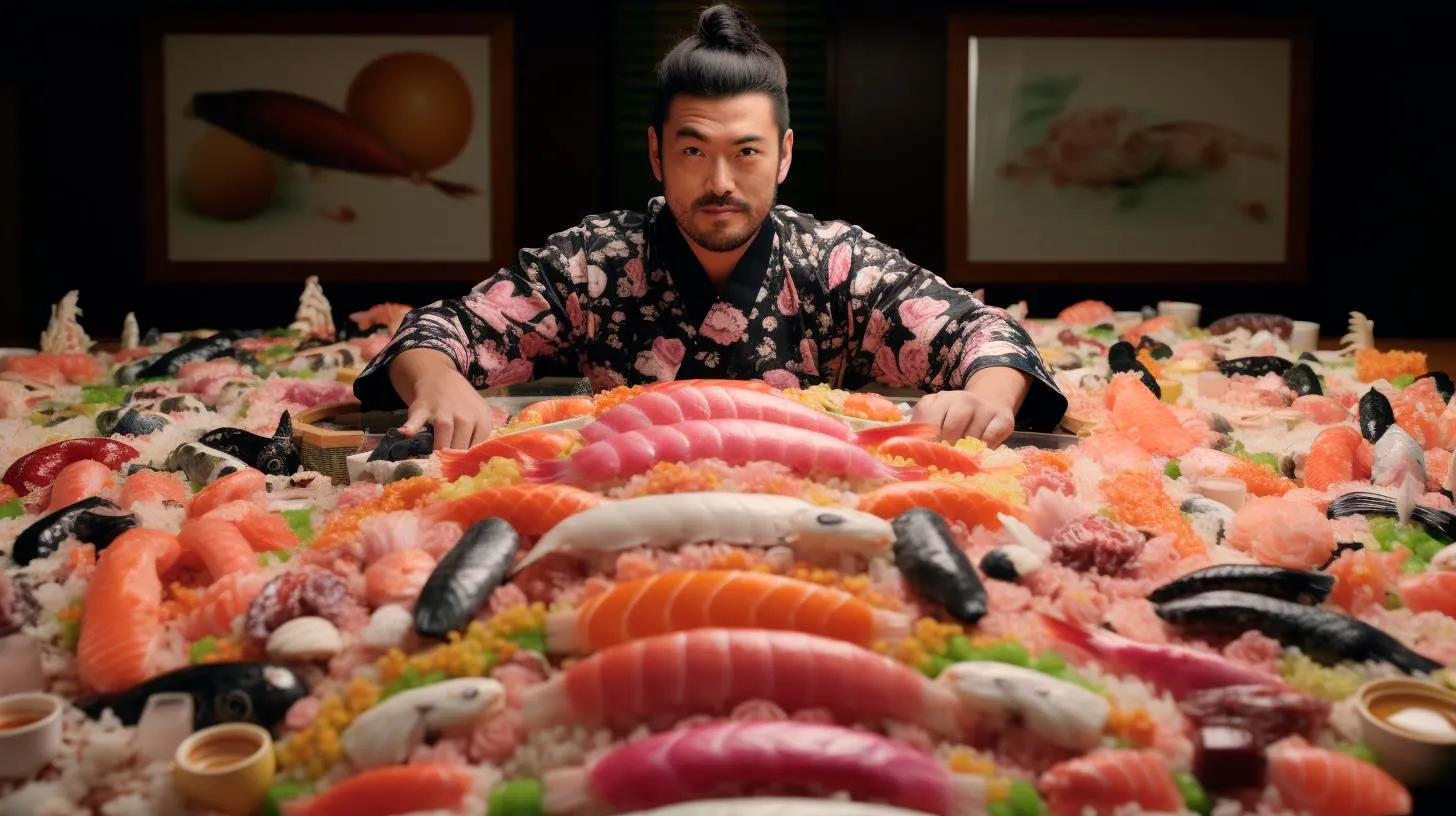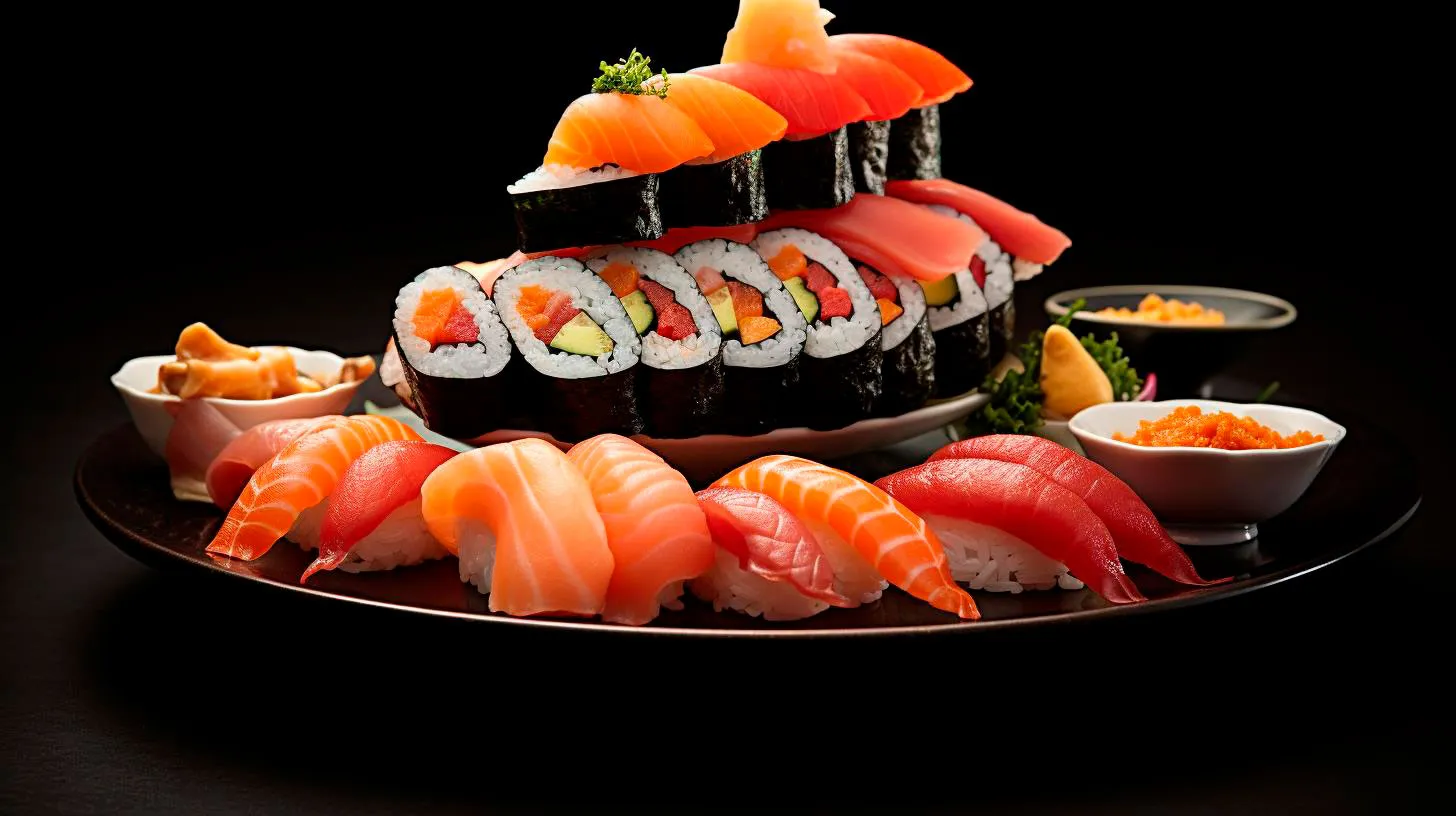Delve into the Symbolic Meaning of Tobiko and Masago in Sushi
Every aspect of sushi, including the type of fish eggs used, holds symbolic meaning, adding depth to the overall experience. In this article, we will explore the symbolic meaning of two popular fish eggs used in sushi: tobiko and masago.
Tobiko: A Burst of Color and Prosperity
Tobiko refers to the roe (fish eggs) of flying fish. These small, crunchy, colorful eggs are known for their vibrant hues, ranging from bright orange to golden yellow. Tobiko not only adds a burst of flavor to sushi but also holds deep symbolic meaning in Japanese culture.
Symbolic Meaning of Tobiko:
- Prosperity: The vibrant color of tobiko symbolizes prosperity and good fortune. It is believed that consuming tobiko brings luck and success in endeavors.
- New Beginnings: Just as flying fish soar across the ocean, tobiko represents new beginnings and a fresh start in life. It encourages individuals to embrace change and take risks.
- Transformation: The life cycle of a flying fish involves an incredible transformation from eggs to mature adults. Tobiko embodies this process of growth and transformation, reminding us of our own potential for personal development.
- Celebration: The vibrant colors of tobiko make it a favorite choice for celebratory sushi dishes. Its presence in sushi symbolizes joy, happiness, and festivities.
With its symbolism deeply rooted in Japanese culture, tobiko not only adds visual appeal but also provides a meaningful culinary experience.
Masago: A Taste of Fertility and Abundance
Masago is another type of fish roe commonly used in sushi. It comes from the capelin, a small fish found in the North Atlantic and Pacific Oceans. With its subtle and delicate flavor, masago offers a unique taste experience. However, it holds even greater symbolic significance.
Symbolic Meaning of Masago:
- Fertility: Masago’s vibrant orange hue symbolizes fertility and abundance. In Japanese culture, it is often associated with the hope for a bountiful and prosperous life.
- Lifeforce: Just as fish eggs represent the future generation of fish, masago embodies the essence of life and the continuation of the circle of existence.
- Wisdom and Intuition: In traditional Japanese beliefs, consuming masago is said to enhance wisdom, intuition, and mental clarity. It is regarded as a beneficial food for intellectual pursuits.
- Celebrating the Seasons: Masago is often incorporated into sushi dishes to celebrate the changing seasons. It reflects the harmony between nature and culinary art.
Through its symbolism, masago adds depth and meaning to every sushi creation it adorns, giving diners a glimpse into the rich cultural heritage behind this culinary art form.
Key Takeaways
When indulging in sushi, it is fascinating to delve into the symbolic meanings associated with each element, including the fish eggs. Here are the key takeaways:
- Tobiko represents prosperity, new beginnings, transformation, and celebration.
- Masago symbolizes fertility, lifeforce, wisdom, and celebrating the seasons.
- Both tobiko and masago offer a visual and symbolic feast for the senses, enriching the experience of enjoying sushi.
- Understanding the symbolism behind sushi enhances our connection with Japanese culture and traditions.
Next time you treat yourself to sushi, take a moment to appreciate the deeper meaning behind the ingredients. Let the vibrant colors and symbolic significance of tobiko and masago elevate your sushi experience, adding a touch of prosperity, fertility, and wisdom to every bite.
Tobiko vs Masago: Unraveling the Distinct Flavors in Sushi
Two commonly used ingredients in sushi, tobiko and masago, are tiny orange fish roes that offer a burst of flavor. In this article, we will dive into the distinctive characteristics of tobiko and masago, exploring their flavors, advantages, and key takeaways. So, let’s embark on this flavorful journey through the world of sushi!
The Basics: Tobiko
Tobiko refers to the eggs of the flying fish, a small and agile creature found in the ocean. These tiny eggs are loved for their vibrant orange color and crunchy texture. One notable feature of tobiko is its natural briny flavor, which adds a delightful umami taste to the sushi. Here are some key points to understand about tobiko:
- Tobiko is rich in omega-3 fatty acids, offering potential health benefits such as improved heart health and brain function.
- The vibrant orange color of tobiko can create an appealing visual presentation of sushi dishes, making them visually enticing.
- Its crunchy texture provides a pleasant contrast to the softness of other sushi ingredients.
- Tobiko pairs well with various sushi rolls, nigiri, or even sashimi, enhancing the overall flavor profile.
- This fish roe is commonly seasoned with soy sauce, mirin, or even wasabi to further elevate its taste.
Exploring Masago
Masago, on the other hand, comes from the roe of the capelin, a small fish found in the cold waters of the North Atlantic and Arctic oceans. Unlike tobiko, masago eggs are slightly smaller in size and exhibit a brilliant orange hue. Let’s uncover some interesting facts about masago:
- Similar to tobiko, masago is an excellent source of omega-3 fatty acids, contributing to a balanced and nutritious diet.
- The delightful burst of briny flavor in masago enhances the overall taste profile of sushi dishes, creating a delightful sensation in each bite.
- Its smaller size makes masago perfect for delicate sushi rolls, providing a harmonious blend of flavors without overpowering other ingredients.
- Masago is often used as a garnish due to its stunning color, adding a pop of vibrancy to plates and enhancing visual appeal.
- This fish roe can also be seasoned with various marinades or sauces to infuse diverse flavors into sushi rolls and other dishes.
Key Takeaways and Flavor Comparisons
While tobiko and masago share certain similarities, they also have distinct flavors that set them apart. Here are some key takeaways to help you differentiate between the two:
- Tobiko has a slightly stronger briny taste compared to masago, making it ideal for those who prefer a more intense flavor experience.
- The crunchy texture of tobiko adds an enjoyable sensation that masago lacks.
- On the other hand, masago has a slightly milder and more subtle briny flavor, which may appeal to individuals seeking a nuanced taste.
- The smaller size of masago eggs allows them to blend seamlessly with other ingredients, while tobiko stands out more prominently.
Now that you have a better understanding of tobiko and masago, you can appreciate the complexity and diversity they bring to sushi dishes. Whether you prefer the vibrant crunch of tobiko or the delicate burst of flavor from masago, these fish roes undoubtedly elevate the overall sushi experience. So, next time you indulge in sushi, don’t forget to savor the distinctive flavors these tiny stars bring to your plate!
The Appeal of Tobiko and Masago in Sushi
These tiny orange pearls not only enhance the aesthetic appeal of sushi but also provide a burst of flavor that complements the other ingredients in the dish.
The Distinction between Tobiko and Masago
While tobiko and masago are both types of fish roe, they come from different species of fish. Tobiko specifically refers to the eggs of flying fish, known for their vibrant color and distinctive crunch. On the other hand, masago is made from the eggs of capelin, a small fish found in the Atlantic and Arctic oceans. It has a smaller size compared to tobiko and a slightly milder flavor.
Key Takeaways:
- Tobiko and masago are types of fish roe commonly used in sushi.
- Tobiko comes from flying fish, while masago comes from capelin.
- Tobiko has a vibrant color and crunch, while masago is smaller with a milder flavor.
The Appeal of Tobiko
Tobiko is known for its beautiful appearance, often featured in bright orange or red hues. The vibrant colors instantly draw attention and make the dish more visually appealing. It adds a delightful crunch to sushi rolls, which adds an interesting textural contrast to the soft rice and other fillings. The natural saltiness of tobiko also enhances the overall flavor profile of the sushi, making it more enjoyable.
Furthermore, tobiko is a rich source of nutrients. It is high in omega-3 fatty acids, which are known to have numerous health benefits. Omega-3 fatty acids promote heart health, reduce inflammation, and support brain function. Including tobiko in your sushi can be a tasty way to boost your omega-3 intake.
Key Takeaways:
- Tobiko’s vibrant colors make sushi visually appealing.
- The crunchiness of tobiko adds an interesting texture to sushi.
- Tobiko is high in omega-3 fatty acids, which benefit heart and brain health.
The Allure of Masago
While masago may not be as visually striking as tobiko, it has its own appeal that sushi lovers appreciate. The small size of masago allows it to blend seamlessly into sushi, evenly distributing its subtle flavors throughout the dish. Its mild taste doesn’t overpower other ingredients, making it a versatile addition to various sushi preparations.
In addition to its flavor, masago provides a nutritional boost. It is a good source of protein and also contains essential vitamins and minerals. Incorporating masago into your sushi can contribute to a well-rounded and nutritious meal.
Key Takeaways:
- Masago blends well with other sushi ingredients due to its small size.
- Its mild flavor makes it versatile for different sushi preparations.
- Masago is a good source of protein and essential vitamins and minerals.
Conclusion
The inclusion of tobiko and masago in sushi not only enhances its visual appeal but also elevates the flavors and textures of the dish. Tobiko’s vibrant colors and pleasing crunch, paired with its omega-3 fatty acid content, make it an enticing addition. On the other hand, masago’s small size and mild flavor offer a subtle enhancement to sushi, along with its nutritional benefits. Whether you prefer the boldness of tobiko or the versatility of masago, these fish roe varieties are sure to delight sushi enthusiasts worldwide.
Exploring the History Behind Tobiko and Masago in Sushi
Let’s embark on a journey to uncover the fascinating history behind these tiny yet impactful ingredients.
Tobiko
Tobiko, also known as flying fish roe, is a popular delicacy in Japanese cuisine. These vibrant little eggs come in a variety of colors, including bright orange, red, yellow, and even black. Traditionally, tobiko was harvested from the roe of flying fish caught in open waters. However, with the increasing demand for sushi, tobiko is now mostly produced through aquaculture.
So what sets tobiko apart from other types of roe? Aside from its eye-catching color, Tobiko has a unique crunchy texture and a subtle, slightly salty flavor. Due to its small size, it offers a burst of umami with every bite, complementing the overall taste of sushi rolls.
Key Features of Tobiko:
- Vibrant colors – adds visual appeal to sushi rolls
- Crunchy texture – provides an interesting contrast
- Subtle salty flavor – enhances the overall taste
According to industry statistics, the global consumption of tobiko has been steadily increasing over the years, with an annual growth rate of 4.5%. This rise in popularity can be attributed to the growing popularity of sushi worldwide.
Masago
Masago, similar to tobiko, is another roe commonly found in sushi. Unlike tobiko, which comes from flying fish, masago is derived from capelin, a small, oily fish found in the northern seas. Masago roe has a naturally light orange color and a slightly smaller size compared to tobiko.
With its delicate and subtle flavor, masago adds a burst of oceanic freshness to sushi rolls. Its tiny eggs provide a gentle pop of texture, creating a delightful mouthfeel. You’ll often find masago in sushi rolls, particularly those with a milder taste profile.
Key Features of Masago:
- Light orange color – adds visual appeal and contrasts with other ingredients
- Delicate flavor – enhances the overall taste without overpowering
- Small size – provides a pleasant texture
Similar to tobiko, masago has experienced a surge in popularity due to the increasing demand for sushi worldwide. Industry experts predict a steady growth rate of 3.8% in the consumption of masago over the next five years.
Key Takeaways
Whether you’re a sushi aficionado or a curious foodie, understanding the history and significance of tobiko and masago enriches the dining experience. Here are the key takeaways:
- Tobiko and masago are types of fish roe commonly used in sushi.
- Tobiko is obtained from flying fish, while masago is derived from capelin.
- Tobiko boasts vibrant colors, a crunchy texture, and a subtle salty flavor.
- Masago has a light orange color, delicate flavor, and small size.
- Both tobiko and masago contribute to the overall taste and texture of sushi rolls.
- The consumption of tobiko and masago has been steadily increasing due to the global popularity of sushi.
So, the next time you savour a sushi roll adorned with these small yet powerful orbs, take a moment to appreciate the rich history and unique qualities that tobiko and masago bring to your plate. Happy sushi indulging!


